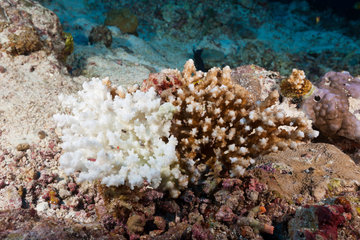New Insights into the Dynamics of Microbial Communities
Under certain circumstances, the abundance of plankton species changes continuously without one species becoming permanently dominant
Researchers at the Max Planck Institute for Evolutionary Biology in Plön, within the Department of Theoretical Biology, characterized a recently discovered dynamical regime of microbial communities and used it to explain empirical patterns of marine plankton. There, strong and diverse interactions, combined with weak dispersal, fuel a continuous turnover of the small set of very abundant species, such that success is ephemeral and every species is equivalent in alternating between rarity and dominance.

Scientists at the Research Group for Dynamics of Microbial Collective focused on understanding the ecological mechanisms responsible for the observed outstanding diversity of microbial life forms. A significant hypothesis under discussion is that complex interactions between different taxa substantially influence the composition of microbial communities. However, strong competition is typically associated with the exclusion of all but a handful of species, clearly delineating ‘winners’ and ‘losers’ in the struggle for survival.
By modelling community dynamics by Lotka-Volterra equations with disordered, mostly competitive, interactions, the researchers found that whenever ‘losers’ are prevented to go extinct and allowed to linger around as rare, the dominant community eventually ends up being subverted. ‘Winner’ species then become rare, and a subset of formerly rare species have a drastic – though ephemeral, again – increase in abundance.
Complex dynamics in communities

A notable discovery of the study is that which species dominates at what moment turns out to be intrinsically unpredictable and species are to a large degree dynamically equivalent. However, even the smallest differences between species affects the probability that they boom, which biases some species to be more often dominant or rare compared to others.
The researchers showed that the essential features of such chaotic dynamic are captured by a much simpler, single-species model, where a representative ‘focal’ species sees the fluctuations of the rest of the community as a noise, whose correlation reflects the time scale of the turnover. This model moreover produces a power-law decay of species abundance, a pattern that is ubiquitous in marine plankton communities.
The insights from this study have not only shed light on a process able to maintain high levels of species diversity, but also opened up potential applications in the analysis of time-resolved environmental recordings, providing significant impetus for future research.
Art meets science
The effect of interaction strength and heterogeneity on community dynamics and diversity, moreover, inspired the production of an original artistic creation combining science with animation, dance and music. The performance was awarded the prize of the public at the ARTEX Festival, held at the Institute of Complex System of Paris (https://iscpif.fr/artex23-prix/), highlighting the potential of mathematical models in public outreach.













